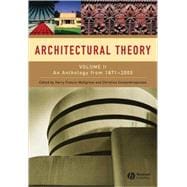
Note: Supplemental materials are not guaranteed with Rental or Used book purchases.
Purchase Benefits
What is included with this book?
| Acknowledgements | |
| General Introduction | |
| Early Modernism. | |
| The Arts and Crafts Movement in Great Britain. | |
| Introduction | |
| John Ruskin from Fors Clavigera (1871) | |
| Christopher Dresser from Studies in Design (1874-76) | |
| Richard Redgrave from Manual of Design (1876) | |
| William Morris from The Prospects of Architecture in Civilization (1881) | |
| Christopher Dresser from Japan: Its Architecture, Art, and Art Manufacturers (1882) | |
| Oscar Wilde from Art and the Handicraftsman (1882) | |
| Arthur H. Mackmurdo from Arbitrary Conditions of Art (1884) | |
| William Morris from The Revival of Architecture (1888) | |
| Walter Crane from The Claims of Decorative Art (1892) | |
| John D. Sedding from Design (1891?) | |
| Charles Rennie Mackintosh from Architecture (1893) | |
| C. Robert Ashbee from A Few Chapters in Workshop Re-Construction and Citizenship (1894). | |
| Continental Reforms | |
| Introduction | |
| Jakob Falke from Art in the House (1871) | |
| George Hirth from The German Renaissance Room (1880) | |
| Robert Dohme from The English House (1888) | |
| Cornelius Gurlitt from Inside the Middle-Class House (1888) | |
| Louis-Charles Boileau from Shops of the Bon Marché in Paris—Grand Staircase (1876) | |
| Charles Blanc from The Fine Arts at the Universal Exposition of 1878 (1878) | |
| Eugène-Emmanuel Viollet-le-Duc from The Buildings of the Universal Exposition of 1878 (1878) | |
| Émile Zola from Au Bonheur des Dames (1883) | |
| Joris-Karl Huysmans from Against Nature (1884) | |
| Samuel Bing from Artistic Japan (1888) | |
| Joseph Eugene Anatole de Baudot from The Architecture of the Universal Exposition of 1889 (1889) | |
| Louis Gonse from The Architecture of the Universal Exposition of 1889 (1889) | |
| Edmond de Goncourt from Journal, mémoires de la vie littéraire (1895). | |
| Reforms in the United States | |
| Introduction | |
| Henry Hudson Holly from Modern Dwellings: Their Construction, Decoration, and Furniture (1876) | |
| Robert Swain Peabody from Georgian Homes of New England (1877) | |
| Clarence Cook from House Beautiful (1877) | |
| Leopold Eidlitz from The Nature and Function of Art: More Especially of Architecture (1881) | |
| Louis Sullivan from Characteristic and Tendencies of American Architecture (1885) | |
| George William Sheldon from Artistic Country-Seats (1886) | |
| John Root, et al from What are the Present Tendencies in Architectural Design in America (1887) | |
| Mariana Griswold Van Rensselaer from Henry Hobson Richardson and His Works (1888) | |
| Friedrich Baumann from Thoughts on Architecture (1889) | |
| Louis Sullivan from Ornament in Architecture (1892) | |
| Montgomery Schuler from Last Words about the World's Fair (1894) | |
| Louis Sullivan from Emotion Architecture as Compared with Intellectual (1894). | |
| Conceptual Underpinnings of Germa | |
| Table of Contents provided by Publisher. All Rights Reserved. |
The New copy of this book will include any supplemental materials advertised. Please check the title of the book to determine if it should include any access cards, study guides, lab manuals, CDs, etc.
The Used, Rental and eBook copies of this book are not guaranteed to include any supplemental materials. Typically, only the book itself is included. This is true even if the title states it includes any access cards, study guides, lab manuals, CDs, etc.